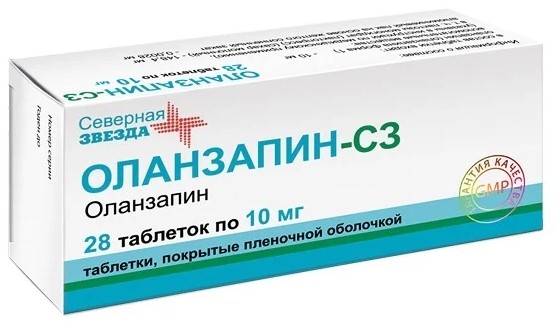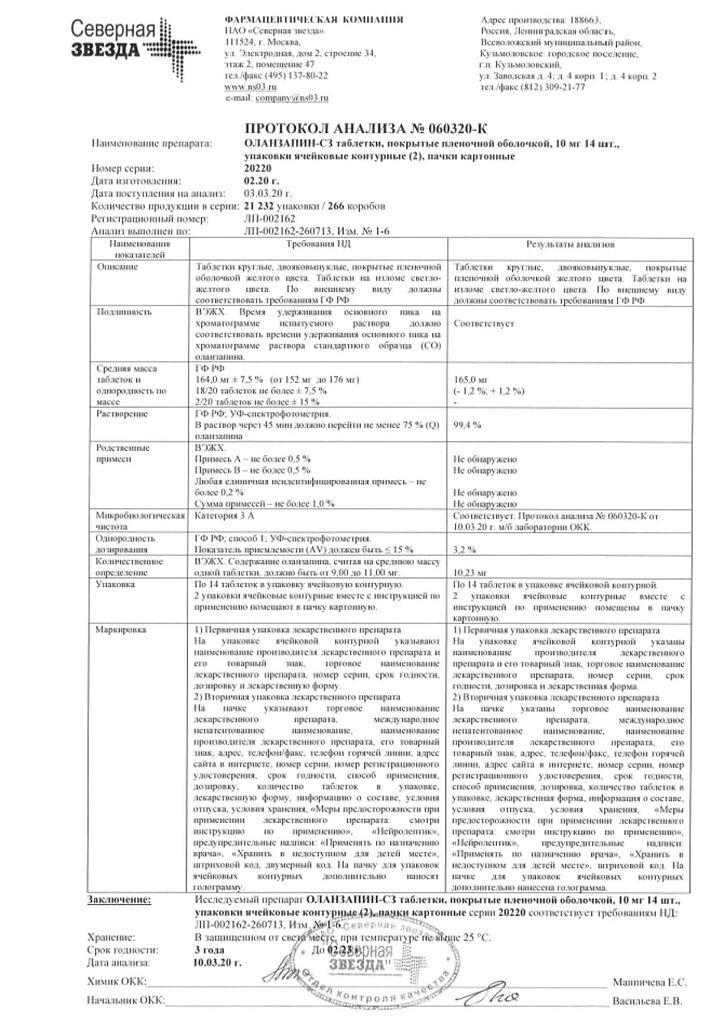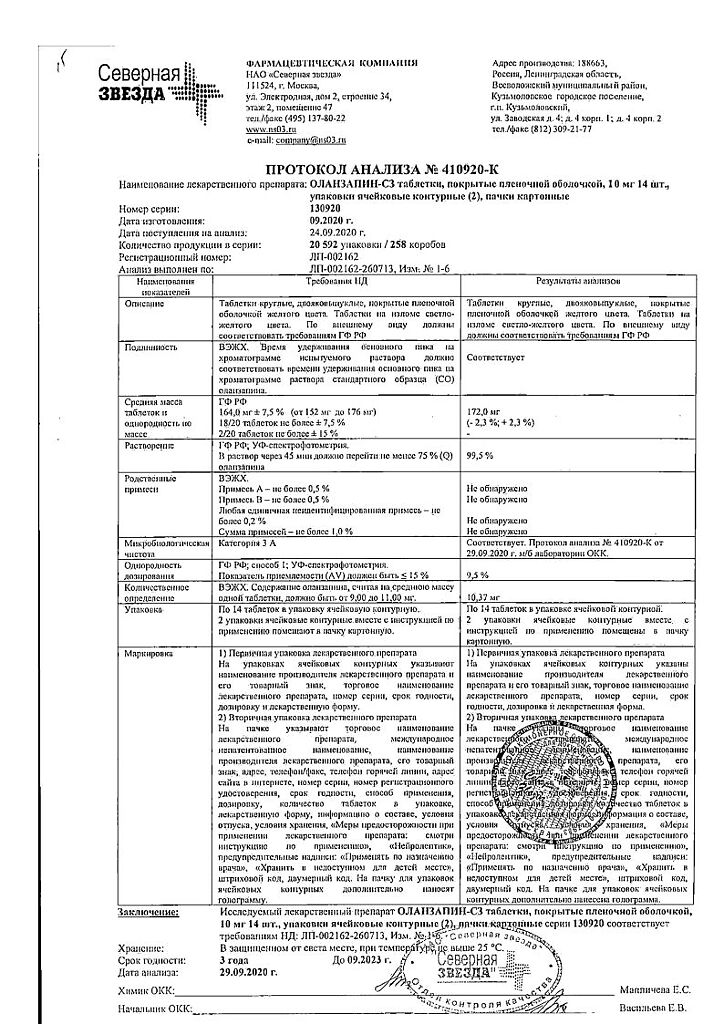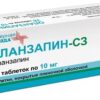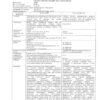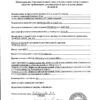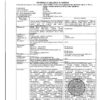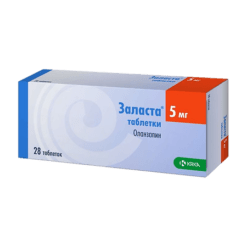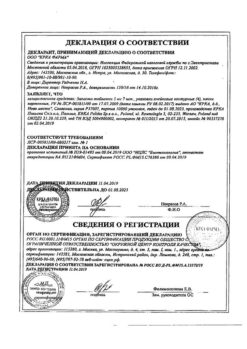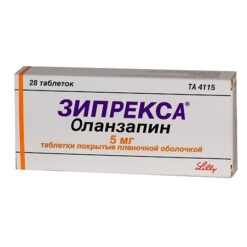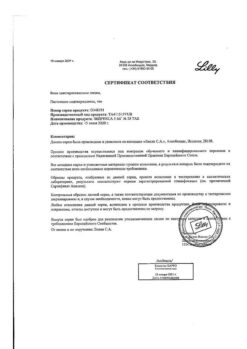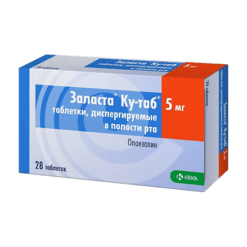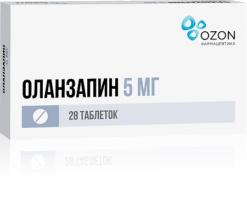No products in the cart.
Olanzapine, 10 mg 28 pcs
€9.86 €8.63
Out of stock
(E-mail when Stock is available)
Description
Pharmacotherapeutic group
Antipsychotic drug (neuroleptic)
ATC code
N05AH03
Pharmacodynamics:
Olanzapine is an antipsychotic (neuroleptic).
In preclinical studies, affinity for 5-NT2A/2C– 5-NT3– 5-NT6-serotonin receptors; D1– D2– D3– D4– D5-dopamine receptors; m-cholinoblocking effects are due to blockade of m1-5-cholinoreceptors; also has an affinity for α1-adreno- and H1-histamine receptors. Antagonism to serotonin dopamine and m-cholinoreceptors has been detected in animal experiments. In vivo and in vitro olanzapine has a more pronounced affinity and activity toward 5-NT2-serotonin receptors compared to D2-dopamine receptors. According to electrophysiological studies, olanzapine selectively reduces excitability of mesolimbic dopaminergic neurons and at the same time has little effect on striatal nerve pathways involved in the regulation of motor functions.
Pharmacokinetics:
After oral administration olanzapine is well absorbed and its maximum plasma concentration is reached after 5-8 hours. The absorption of olanzapine is independent of food intake. Studies with different doses ranging from 1 mg to 20 mg have shown that plasma concentrations of olanzapine vary linearly and in proportion to the dose. Olanzapine is metabolized in the liver by conjugation and oxidation processes. The main circulating metabolite is 10-N-glucuronide, which theoretically does not penetrate the blood-brain barrier.
The CYP1A2 and CYP2D6 cytochrome P450 isoenzymes are involved in the formation of N-desmethyl and 2-hydroxymethyl metabolites of olanzapine. Both metabolites had significantly less pronounced in vivo pharmacological activity than olanzapine in animal studies. The main pharmacological activity of the drug is due to the parent substance olanzapine.
In healthy volunteers after oral administration, the mean half-life (T1/2) was 33 hours (21-54 hours for 5-95%) and the mean plasma clearance of olanzapine was 26 l/h (12-47 l/h for 5-95%).
Pharmacokinetic parameters vary by smoking sex and age (see table):
Characteristics patients | Half-life (hours) | Plasma clearance (l/h) | ||||||||
Non-smokers | 386 | 186 | ||||||||
Smokers | 304 | 277 | ||||||||
Women | 367 | 189 | ||||||||
323 | 273 | |||||||||
Elderly (65 years and older) | 518 | 175 | ||||||||
338 | 182 |
Indications
Indications
Schizophrenia.
Bipolar affective disorder type I. Olanzapine, alone or in combination with lithium or valproic acid, is indicated for the treatment of acute manic or mixed episodes in bipolar affective disorder with or without psychotic features and with or without rapid cycling. Olanzapine is indicated for the prevention of relapse in patients with bipolar disorder in whom olanzapine has been effective in treating the manic phase.
In combination with fluoxetine, olanzapine is indicated for the treatment of depressive episodes in bipolar disorder.
Treatment-resistant depression. In combination with fluoxetine, olanzapine is indicated for the treatment of treatment-resistant depression in adult patients (major depressive episodes with a history of ineffective use of two antidepressants at a dose and duration of therapy adequate for this episode).
Pharmacological effect
Pharmacological effect
Pharmacotherapeutic group
Antipsychotic (neuroleptic)
ATX code
N05AH03
Pharmacodynamics:
Olanzapine is an antipsychotic (neuroleptic).
Preclinical studies have established affinity for 5-HT2A/2C-5-HT3-5-HT6-serotonin receptors; D1- D2- D3- D4- D5 dopamine receptors; m-anticholinergic effects are due to blockade of m1-5 cholinergic receptors; also has an affinity for α1-adrenergic and H1-histamine receptors. Animal experiments revealed antagonism towards serotonin dopamine and m-cholinergic receptors. In vivo and in vitro, olanzapine has a more pronounced affinity and activity for 5-HT2-serotonin receptors compared to D2-dopamine receptors.
According to electrophysiological studies, olanzapine selectively reduces the excitability of mesolimbic dopaminergic neurons and at the same time has a slight effect on striatal nerve pathways involved in the regulation of motor functions.
Pharmacokinetics:
After oral administration, olanzapine is well absorbed and its maximum plasma concentration is reached after 5-8 hours. The absorption of olanzapine is not affected by food intake. Studies with different doses ranging from 1 mg to 20 mg have shown that olanzapine plasma concentrations vary linearly and proportionally to dose. Olanzapine is metabolized in the liver as a result of conjugation and oxidation processes. The main circulating metabolite is 10-N-glucuronide, which theoretically does not cross the blood-brain barrier.
Cytochrome P450 isoenzymes CYP1A2 and CYP2D6 are involved in the formation of N-desmethyl and 2-hydroxymethyl metabolites of olanzapine. Both metabolites had significantly less pharmacological activity in vivo than olanzapine in animal studies. The main pharmacological activity of the drug is due to the parent substance olanzapine.
In healthy volunteers, after oral administration, the mean half-life (T1/2) was 33 hours (21-54 hours for 5-95%) and the mean plasma clearance of olanzapine was 26 L/h (12-47 L/h for 5-95%).
Pharmacokinetic parameters vary depending on smoking gender and age (see table):
Characteristics
patients
Half-life (hours)
Plasma clearance (l/h)
Non-smokers
386
186
Smoking
304
277
Women
367
189
Men
323
273
Elderly (65 years and older)
518
175
Under 65 years old
338
182
Special instructions
Special instructions
Neuroleptic malignant syndrome. Neuroleptic malignant syndrome (NMS) can develop during treatment with any antipsychotics, including olanzapine. Clinical manifestations of NMS include a significant increase in body temperature, muscle rigidity, changes in mental status and autonomic disturbances (unstable pulse or blood pressure, tachycardia, cardiac arrhythmias, increased sweating).
Additional signs may include increased creatine phosphokinase levels, myoglobinuria (rhabdomyolysis), and acute renal failure. Clinical manifestations of NMS or a significant increase in body temperature without other symptoms of NMS require discontinuation of all antipsychotics including olanzapine.
Tardive dyskinesia. In comparative studies lasting more than 6 weeks, treatment with olanzapine was significantly less likely to be accompanied by the development of dyskinesia requiring drug correction than the use of haloperidol. However, the risk of tardive dyskinesia should be taken into account during long-term therapy with antipsychotics. If signs of tardive dyskinesia develop, it is recommended to reduce the dose or discontinue the drug Olanzapine. Symptoms of tardive dyskinesia may increase or manifest after discontinuation of the drug.
Use in elderly patients with psychosis due to dementia. Cerebrovascular adverse events (eg, stroke, transient ischemic attack), including deaths, were observed in studies of olanzapine in elderly patients with psychosis due to dementia. In placebo-controlled studies, there was a higher incidence of cerebrovascular adverse events in patients in the olanzapine group compared with the placebo group (13% vs. 04%, respectively).
These patients had previous risk factors (cerebrovascular disorders (history), transient ischemic attack, arterial hypertension, smoking) as well as concomitant diseases and/or taking medications over time associated with cerebrovascular disorders.
The effectiveness of olanzapine in elderly patients with psychosis due to dementia has not been established. In this category of patients in placebo-controlled clinical trials, the incidence of deaths in the olanzapine group was higher than in the placebo group (35% versus 15%, respectively). The main risk factors for increased mortality in this group of patients when treated with olanzapine are age ≥80 years, sedation, concomitant use with benzodiazepines, or the presence of pulmonary pathology (for example, pneumonia with or without aspiration).
Elderly patients with dementia-related psychosis treated with atypical psychotics are at increased risk of death compared with placebo. Olanzapine is not recommended for the treatment of patients with psychosis due to dementia.
There are insufficient data to establish differences in the incidence of cerebrovascular events and/or mortality (compared with placebo) and risk factors in this group of patients between oral and intramuscular olanzapine.
Liver dysfunction. In some cases, taking Olanzapine, usually in the early stages of therapy, was accompanied by a transient asymptomatic increase in liver transaminases (aspartate aminotransferase and alanine aminotransferase) in the blood serum. Rare cases of hepatitis have been reported. In very rare cases, hepatic cholestasis and other mixed liver damage have been observed. Particular caution is required when serum aspartate aminotransferase and/or alanine aminotransferase levels increase in patients with liver failure with limited liver functional reserve or in patients receiving treatment with potentially hepatotoxic drugs.
If aspartate aminotransferase and/or alanine aminotransferase levels increase during treatment with olanzapine, the patient should be closely monitored and the dose reduced if necessary.
Hyperglycemia and diabetes mellitus. There is a higher prevalence of diabetes mellitus in patients with schizophrenia. Very rarely, cases of hyperglycemia developing diabetes mellitus or exacerbation of pre-existing diabetes mellitus, ketoacidosis and diabetic coma have been reported. A causal relationship between antipsychotic drugs and these conditions has not been established. Clinical monitoring of patients with diabetes mellitus or with risk factors for its development is recommended.
Hematological changes. The use of Olanzapine in patients with clozapine-dependent neutropenia or agranulocytosis (history) was not accompanied by relapses of these disorders.
Dopaminergic antagonism. Olanzapine exhibits dopamine antagonism and could theoretically inhibit the effects of levodopa and dopamine agonists.
Parkinson’s disease. The use of olanzapine is not recommended in the treatment of dopamine receptor agonist-induced psychosis in Parkinson’s disease.
In clinical studies in patients with drug-induced psychosis (dopamine receptor agonist) in Parkinson’s disease, increased parkinsonian symptoms were observed very often (≥10%) and at a higher frequency than in the placebo group. Hallucinations were also observed very frequently (≥10%) and at a higher frequency than in the placebo group.
Change in lipid profile. During placebo-controlled studies, undesirable changes in lipid profile were observed in patients receiving olanzapine. Clinical observation is recommended (see “Side effects”).
Development of the risk of sudden death. Clinical experience with any antipsychotic, including olanzapine, has shown a similar dose-dependent twofold increase in the risk of death due to acute heart failure compared with death due to acute heart failure in patients not using antipsychotics.
Cramps. Olanzapine should be used with caution in patients with a history of seizures or exposure to factors that lower the seizure threshold. In such patients, seizures were rarely observed during olanzapine treatment.
M-anticholinergic activity. In clinical studies, olanzapine therapy was rarely accompanied by m-anticholinergic side effects. However, clinical experience with olanzapine in patients with concomitant diseases is limited, so caution is recommended when prescribing olanzapine to patients with clinically significant prostatic hyperplasia, paralytic ileus, angle-closure glaucoma and similar conditions.
Neutropenia. Olanzapine should be used with caution in patients with low levels of white blood cells and/or neutrophils in the blood; receiving drugs that can cause neutropenia; with suppression of bone marrow function caused by radiation or chemotherapy; as well as in patients with eosinophilia and/or myeloproliferative diseases. Neutropenia has been reported primarily when olanzapine is combined with valproate.
Duration of the QT interval. In clinical trials, clinically significant prolongation of the QT interval (QT interval adjusted by Fridericius [QTcF] ≥500 ms in patients with baseline QTcF <500 ms) was observed infrequently in patients receiving olanzapine, with no significant difference from placebo in the incidence of cardiac adverse events.
However, as with other antipsychotics, caution is recommended when prescribing olanzapine in combination with drugs that can prolong the QT interval, especially in elderly patients with congenital prolongation of the QT interval, congestive heart failure, myocardial hypertrophy, hypokalemia and hypomagnesemia.
Cancellation of therapy. In cases of abrupt discontinuation of olanzapine, acute development of sweating, insomnia, tremor, anxiety, nausea and vomiting has been reported extremely rarely (<001%).
Thromboembolism. Venous thromboembolism has been reported extremely rarely (<001%) during olanzapine therapy. The presence of a cause-and-effect relationship between taking olanzapine and venous thromboembolism has not been established. However, given that patients with schizophrenia often have acquired risk factors for venous thromboembolism, it is necessary to conduct a cumulative assessment of all possible risk factors for the development of this complication, including immobilization of patients, and take the necessary preventive measures.
General activity in relation to the central nervous system. Given the primary central nervous system effects of olanzapine, caution should be exercised when olanzapine is used in combination with other centrally acting drugs and alcohol.
Postural hypotension. Postural hypotension was observed infrequently in clinical studies of olanzapine in the elderly. As with other antipsychotics, when olanzapine is prescribed to patients over 65 years of age, periodic monitoring of blood pressure is recommended.
Children and teenagers under 18 years of age. Olanzapine is not recommended for use in children and adolescents under 18 years of age due to the lack of sufficient data on efficacy and safety. In short-term studies conducted in adolescents 13-17 years of age, there was a greater increase in body weight and changes in lipid and prolactin concentrations than in similar studies in adults.
Impact on the ability to drive vehicles. Wed and fur.:
Patients taking Olanzapine should exercise caution when driving vehicles and engaging in potentially hazardous activities that require increased concentration and psychomotor speed, since olanzapine may cause drowsiness.
Active ingredient
Active ingredient
Olanzapine
Composition
Composition
1 film-coated tablet contains:
dosage 10 mg
active substance: olanzapine (olanzapine form 1) 10 mg;
excipients: lactose monohydrate (lactopress) (milk sugar) 148.4 mg; calcium stearate 1.6 mg;
shell composition: opadry II (polyvinyl alcohol, partially hydrolyzed 1.6 mg; talc 0.592 mg; titanium dioxide E 171 0.8748 mg; macrogol (polyethylene glycol 3350) 0.808 mg; aluminum varnish based on quinoline yellow 0.1204 mg; aluminum varnish based on sunset yellow 0.0028 mg; dye iron oxide (II) yellow 0.0012 mg; aluminum varnish based on indigo carmine 0.0008 mg).
Pregnancy
Pregnancy
Olanzapine should be prescribed during pregnancy only if the potential benefit to the patient significantly outweighs the potential risk to the fetus. Patients should be warned that if they become pregnant or plan to become pregnant during treatment with Olanzapine, they should inform their doctor.
Olanzapine is excreted in breast milk. The mean dosage received by the child (mg/kg) upon reaching maternal steady-state concentration was 18% of the maternal olanzapine dose (mg/kg). Breastfeeding is not recommended during therapy with Olanzapine.
Contraindications
Contraindications
Established hypersensitivity to any of the components of the drug.
Lactase deficiency, lactose intolerance, glucose-galactose malabsorption.
Use in children. The effectiveness and safety of olanzapine in people under 18 years of age has not been proven.
With caution:
Liver failure, clinically significant prostatic hypertrophy, angle-closure glaucoma, paralytic ileus.
Olanzapine should be used with caution in patients with a decreased number of leukocytes and/or neutrophils in the peripheral blood due to various reasons; with signs of suppression or toxic impairment of bone marrow function under the influence of drugs (history); with suppression of bone marrow function due to concomitant disease, radiotherapy or chemotherapy (history); with hypereosinophilia or myeloproliferative disease.
Olanzapine should be used with caution in patients with a history of epileptic seizures or in the presence of factors that lower the seizure threshold. In such patients, seizures were rarely observed during olanzapine treatment.
Given the primary effect of olanzapine on the central nervous system, caution should be exercised when using Olanzapine in combination with other centrally acting drugs and alcohol.
Side Effects
Side Effects
The table below summarizes the main side effects and their frequency reported during clinical trials and/or in the post-marketing period.
Very often
(≥10%)
Often
(<10% and ≥1%)
Uncommon
(≥01% and<1%)
Frequency unknown
(frequency cannot be determined from available data)
Disorders of the circulatory and lymphatic systems
Eosinophilia
Leukopenia
Neutropenia
Thrombocytopenia
Immune system disorders
Allergic reactions
Metabolic and nutritional disorders
Weight gain1
Increased cholesterol concentration23
Increased glucose concentration4
Increased triglyceride concentrations25
Glucosuria
Decreased appetite
Development or decompensation of diabetes mellitus, in some cases accompanied by ketoacidosis and diabetic coma, including death Hypothermia
Nervous system disorders
Drowsiness
Dizziness Akathisia6 Parkinsonism6 Dyskinesia6
Seizures in patients with a history of seizures or risk factors for seizures Neuroleptic malignant syndrome
Dystonia (including oculogyric crisis) Tardive dyskinesia
Withdrawal syndrome7
Heart disorders
Bradycardia Prolongation of the QTc interval
Ventricular tachycardia/ventricular fibrillation sudden death
Vascular disorders
Orthostatic hypotension
Pulmonary embolism
Deep vein thrombosis
Digestive system disorders
Short-term anticholinergic effects including constipation and dry mouth
Pancreatitis
Disorders of the liver and biliary tract
Transient increase in the activity of hepatic transferases (ALT AST), especially in the early period of treatment
Hepatitis (including liver cell hepatocellular or mixed)
Skin and subcutaneous tissue disorders
Rash
Photosensitivity reaction
Alopecia
Musculoskeletal disorders
Rhabdomyolysis
Renal and urinary tract disorders
Urinary incontinence
Delayed onset of urination
Disorders of the genital organs and breast
Priapism
General disorders
Asthenia
Fatigue
Edema
Laboratory data
Increased plasma prolactin concentration8
Increased creatine phosphokinase activity, increased concentration of total bilirubin
Increased alkaline phosphatase activity
1 Clinically significant weight gain was observed for all patient groups, regardless of body mass index. An increase in body weight of 7% or more of the mean after a short course of treatment (average duration – 47 days) was very common (222%), an increase of 15% or more was common (42%), and an increase of 25% or more was infrequent (08%).
In patients receiving long-term treatment (at least 48 weeks), increases of ≥7%, ≥15% and ≥25% were very common (644% 317% 123%, respectively).
2The mean increase in fasting lipid concentrations (low-density lipoprotein cholesterol (LDL) triglycerides) was more pronounced in patients without baseline signs of lipid disorders.
3An increase in cholesterol concentrations from normal fasting values (<517 mmol/L) to elevated values (≥62 mmol/L) was often observed. Changes in cholesterol concentrations from fasting borderline values (≥517 62 mmol/L) were very common.
4 An increase in glucose concentration from normal fasting values (556 – < 7 mmol/L) to elevated (≥ 7 mmol/L) was very common.
5 An increase in triglyceride concentrations from normal fasting values (<169 mmol/L) to elevated values (≥226 mmol/L) was often observed. Changes in triglyceride concentrations from borderline fasting levels (≥169 - <226 mmol/L) to elevated levels (≥226 mmol/L) were very common.
6 In clinical trials, parkinsonism and dystonia were more common in patients taking olanzapine, but the difference with placebo was not statistically significant.
In patients taking olanzapine, cases of parkinsonism, akathisia, and dystonia were observed less frequently than in patients receiving titrated doses of haloperidol. Due to the lack of detailed information on the history of acute and tardive dyskinesias in patients, it is currently impossible to conclude that olanzapine is less likely to cause the development of tardive dyskinesias or other late extrapyramidal syndromes.
7 When olanzapine was abruptly discontinued, symptoms such as sweating, insomnia, tremor, anxiety, nausea and vomiting were observed.
8 In clinical studies of up to 12 weeks, plasma prolactin concentrations exceeded the upper limit of normal in approximately 30% of patients with normal baseline prolactin values. In most of these patients, the increase in prolactin concentrations was moderate and less than 2 times the upper limit of normal. In patients taking olanzapine, disorders of the genital organs and mammary gland, possibly related to taking olanzapine (amenorrhea, breast enlargement, galactorrhea in women, gynecomastia and breast enlargement in men), were uncommon. Sexual dysfunction possibly related to olanzapine (erectile dysfunction in men, decreased libido in men and women) was observed frequently.
Adverse effects in special groups of patients
A very common (≥10%) adverse effect with olanzapine in clinical trials in patients with dementia-related psychosis was gait disturbance and falls.
Frequent (<10% and ≥1%) adverse effects with olanzapine in elderly patients with dementia-related psychosis were urinary incontinence and pneumonia.
In clinical studies in patients with drug-induced psychosis (dopamine receptor agonist) in Parkinson’s disease, increased parkinsonian symptoms were observed very often (≥10%) and at a higher frequency than in the placebo group. Hallucinations were also observed very frequently (≥10%) and at a higher frequency than in the placebo group.
In patients with bipolar mania receiving olanzapine in combination with lithium or valproic acid, very common (>10%) adverse effects were weight gain, dry mouth, increased appetite, tremor, and frequent (<10% and ≥1%) speech disturbance.
Interaction
Interaction
The metabolism of olanzapine may be altered by inhibitors or inducers of cytochrome P450 isoenzymes that exhibit specific activity against the CYP1A2 isoenzyme. The clearance of olanzapine increases in smoking patients and in patients taking carbamazepine (due to an increase in the activity of the CYP1A2 isoenzyme). Known potential inhibitors of the CYP1A2 isoenzyme may reduce the clearance of olanzapine.
Olanzapine is not a potential inhibitor of the activity of the CYP1A2 isoenzyme; therefore, when taking the drug Olanzapine, the pharmacokinetics of drugs such as theophylline, which are mainly metabolized with the participation of the CYP1A2 isoenzyme, do not change.
A single dose of Olanzapine during therapy with the following drugs was not accompanied by suppression of the metabolism of these drugs: imipramine or its metabolite desipramine (CYP2D6 isoenzyme, CYP3A isoenzyme, CYP1A2 isoenzyme), warfarin (CYP2C19 isoenzyme), theophylline (CYP1A2 isoenzyme), or diazepam (CYP3A4 isoenzyme, CYP2C19 isoenzyme). There were also no signs of drug interactions when using olanzapine in combination with lithium and biperidine.
Against the background of steady-state concentrations of olanzapine, no changes in the pharmacokinetics of ethanol were observed. However, taking ethanol together with olanzapine may be accompanied by increased pharmacological effects of olanzapine (sedation).
A single dose of an aluminum- or magnesium-containing antacid or cimetidine did not interfere with the oral bioavailability of olanzapine. Co-administration of activated charcoal reduced the oral bioavailability of olanzapine to 50-60%.
Fluoxetine (60 mg once or 60 mg daily for 8 days) causes an increase in the maximum concentration (Cmax) of olanzapine by an average of 16% and a decrease in olanzapine clearance by an average of 16%, which has no clinical significance (no dose adjustment of olanzapine is required). Fluvoxamine, an inhibitor of the CYP1A2 isoenzyme, reduces the clearance of olanzapine and increases the Cmax of olanzapine in non-smoking women by 54% and by 77% in smoking men. The mean increase in olanzapine AUC was 52% and 108%, respectively. Low doses of olanzapine should be prescribed to patients receiving concomitant treatment with fluvoxamine.
In vitro studies using human liver microsomes have shown that olanzapine slightly inhibits the formation of valproate glucuronide (the main pathway of valproate metabolism). Valproate also has little effect on the metabolism of olanzapine in vitro. Therefore, a clinically significant pharmacokinetic interaction between olanzapine and valproate is unlikely.
According to in vitro studies using human liver microsomes, olanzapine also showed extremely little potential in suppressing the activity of the following cytochrome P450 isoenzymes: CYP1A2 isoenzyme CYP2C9 isoenzyme CYP2C19 isoenzyme CYP2D6 isoenzyme CYP3A isoenzyme.
Overdose
Overdose
Symptoms. Very common (frequency ≥10%) symptoms are tachycardia, agitation/aggression, articulation disorder, various extrapyramidal disorders and disturbances of consciousness of varying severity (from sedation to coma). Other clinically significant consequences of olanzapine overdose are delirium, seizures, neuroleptic malignant syndrome, respiratory depression, aspiration, increased or decreased blood pressure (BP), cardiac arrhythmias (< 2% of overdose cases), cardiac and respiratory arrest.
The minimum dose for an acute overdose with a fatal outcome is 450 mg; the maximum dose for an overdose with a favorable outcome (survival) is 1500 mg.
Treatment. There is no specific antidote for olanzapine. Inducing vomiting is not recommended. Standard procedures for overdose may be indicated (gastric lavage, administration of activated charcoal). Co-administration of activated charcoal showed a decrease in the bioavailability of olanzapine when taken orally by up to 50-60%. Symptomatic treatment is indicated in accordance with the clinical condition and control over the functions of vital organs, including treatment of arterial hypotension, circulatory disorders and maintaining respiratory function.
Epinephrine, dopamine and other sympathomimetics that are beta-adrenergic receptor agonists should not be used, since stimulation of these receptors may aggravate arterial hypotension.
Storage conditions
Storage conditions
In a dry place, protected from light, at a temperature not exceeding 25 ° C.
Keep out of the reach of children.
Shelf life
Shelf life
3 years.
Do not use after the expiration date indicated on the package.
Manufacturer
Manufacturer
North Star NAO, Russia
Additional information
| Shelf life | 3 years. Do not use after the expiration date printed on the package. |
|---|---|
| Conditions of storage | Store in a dry place protected from light at a temperature not exceeding 25 °С. Keep out of reach of children. |
| Manufacturer | North Star NAO, Russia |
| Medication form | pills |
| Brand | North Star NAO |
Other forms…
Related products
Buy Olanzapine, 10 mg 28 pcs with delivery to USA, UK, Europe and over 120 other countries.

